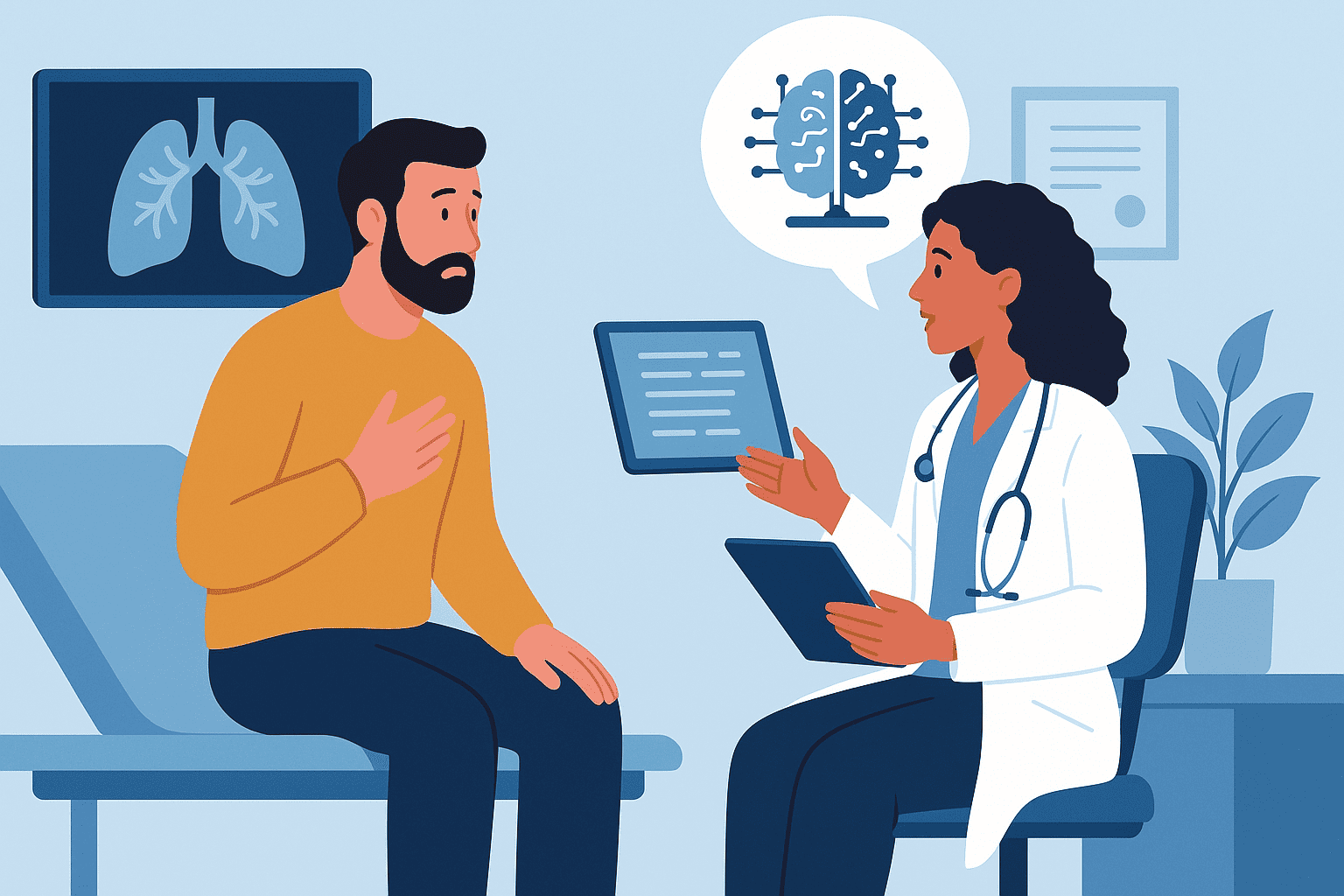Updated on: July 14, 2025
Pulmonologists are on the front lines of respiratory health—treating everything from asthma and COPD to lung cancer and sleep apnea. But for each patient, documentation is anything but simple. You’re charting symptoms, spirometry data, imaging, procedures, and long-term treatment plans.
The result? Complex notes that eat into your time and energy.
That’s where DocScrib, an AI medical scribe for pulmonology, makes the difference. It listens during patient visits—capturing everything from dyspnea history to bronchoscopy findings—and generates complete, structured notes in real time. So you can breathe easier.
Why Pulmonology Documentation Is Challenging
Your average pulmonology note must include:
-
Chief complaint and symptom timeline (e.g., dyspnea, cough, wheezing, hemoptysis)
-
Pulmonary function test (PFT) results and interpretation
-
Imaging summaries (e.g., CXR, CT chest, PET scans)
-
Oxygen saturation and vitals
-
Smoking/tobacco use history and pack-years
-
Treatment plans: bronchodilators, steroids, CPAP, antibiotics, biologics
-
Procedure notes: bronchoscopy, thoracentesis, biopsy
-
Sleep study data and follow-up
These aren’t just long—they require medical precision and regulatory compliance.
What Is an AI Medical Scribe for Pulmonology?
An AI pulmonology scribe like DocScrib listens to your clinical conversations (in person or via telehealth) and generates structured, EMR-ready notes in real time.
Unlike generic dictation tools, DocScrib understands pulmonary terminology. It captures symptom duration, smoking history, spirometry values, imaging interpretations, and procedure details—accurately and instantly.
How DocScrib Works in Pulmonology Practice
-
Start the encounter
The AI listens securely and silently as you interact with the patient. -
Real-time processing
It understands pulmonary complaints, test results, and treatment plans. -
Note generation
SOAP, consult, and follow-up notes are created instantly. -
Quick review + EMR sync
You edit (if needed), approve, and push the note to your EMR—no typing required.
Benefits of AI Medical Scribes for Pulmonologists
🫁 Captures Pulmonary Symptoms Accurately
Dyspnea, orthopnea, cough, hemoptysis, chest tightness—all auto-documented in context.
🩺 Auto-Logs PFT Results and Interpretation
FEV1, FVC, DLCO, bronchodilator response—parsed and recorded in your note.
📷 Summarizes Imaging Clearly
CT thorax, chest X-ray, HRCT, and PET scan impressions included seamlessly.
🔄 Tracks Chronic Lung Disease Progression
For COPD, ILD, asthma, and bronchiectasis—monitors over time.
💬 Documents Tobacco History and Counseling
Pack-years, quit date, cessation support—all included.
🛌 Supports Sleep and CPAP Documentation
Sleep study results, AHI, compliance data, and patient feedback tracked.
🧪 Procedure Notes Made Easy
Bronchoscopy findings, lavage results, thoracentesis notes—auto-inserted.
🕒 Saves 1–2 Hours Daily
Replaces manual note-writing with intelligent automation.
DocScrib Features Built for Pulmonology
-
Pulmonary SOAP Templates
For asthma, COPD, lung nodules, ILD, pleural effusion, pneumonia, and more. -
PFT & Oximetry Integration
Auto-inserts spirometry results and interpretations with minimal prompts. -
CT and Imaging Summary Parser
Captures radiology impressions directly into objective or assessment. -
Tobacco Use Tracker
Includes full smoking history, cessation efforts, and follow-up. -
Procedure Templates
Built-in for bronchoscopies, thoracentesis, sleep studies, and pulmonary rehab.
Common Use Cases in Pulmonary Clinics
-
COPD & Asthma Follow-Ups: Symptoms, PFT, med adjustments
-
ILD Monitoring: CT findings, O2 need, fibrosis score tracking
-
Sleep Apnea Management: AHI, CPAP compliance, daytime symptoms
-
Post-Bronchoscopy Review: Pathology, lavage, next steps
-
Smoking Cessation Counseling: Tobacco use, motivational interviewing
-
Lung Nodule Workup: Imaging follow-up, biopsy decisions
-
Post-COVID Sequelae: Fatigue, DLCO drop, fibrosis risk
Real-World Example: Pulmonary Group in New York
📍 5 pulmonologists + 2 sleep specialists adopted DocScrib
Within 30 Days:
-
Cut charting time by 70%
-
Improved consistency in spirometry documentation
-
Streamlined bronchoscopy procedure notes
-
Boosted patient throughput by 15% without reducing quality
💬 “I used to spend hours typing CT summaries, PFT values, and tobacco history. Now DocScrib does it all while I talk—and it’s more accurate than ever.”
DocScrib vs. Manual Documentation in Pulmonology
| Feature | Manual Notes | DocScrib AI Scribe |
|---|---|---|
| PFT Data Capture | Manually entered | ✅ Auto-parsed + formatted |
| Imaging Summaries | Copy/paste from report | ✅ Structured + concise |
| Tobacco Use Tracking | Inconsistent | ✅ Standardized + complete |
| Bronchoscopy & Procedure Notes | Separate dictation | ✅ Integrated real-time |
| Sleep Study & CPAP Logs | Manually typed | ✅ Auto-inserted |
| Chronic Disease Progression | Hard to follow | ✅ Tracked over visits |
| EMR Integration | Multi-step | ✅ 1-click sync |
FAQs: AI Scribes for Pulmonology
Q1. Can DocScrib log full spirometry (PFT) results?
Yes—DocScrib understands and documents FEV1, FVC, DLCO, bronchodilator response, and interpretation.
Q2. Does it support sleep medicine visits?
Absolutely. AHI scores, CPAP compliance, mask issues, and daytime sleepiness are all captured.
Q3. Can I use it for procedures like bronchoscopy?
Yes—DocScrib includes procedural note templates for bronchoscopies, thoracentesis, and sleep studies.
Q4. What about documenting long COVID or ILD patients?
DocScrib tracks symptoms, imaging, and pulmonary function changes over time, perfect for chronic care.
How to Get Started with DocScrib for Pulmonology
-
Book your free demo
-
Select “Pulmonology” as your specialty
-
Customize templates for COPD, ILD, asthma, procedures, and sleep care
-
Start using real-time AI notes in your clinic within days
Conclusion: Let Your Care Breathe—Not Your Charting
Respiratory medicine is fast-moving and data-heavy—but your documentation doesn’t have to slow you down.
DocScrib’s AI medical scribes for pulmonology give you the speed, structure, and accuracy to match the complexity of your specialty—without the charting burden.
🩺 See how DocScrib transforms your notes → Try DocScrib for Pulmonology
